Mashatu: Land of the Giants
.jpg) |
| Mashatu, 2022. |
It was a long 26 hour journey to get to Africa. By the time we took off from Los Angeles, we had been delayed for over an hour. To make matters worse, when we got to Amsterdam our gate was still occupied. By the time our 787 Dreamliner finally parked at the gate, we had just 30 minutes to make our connection. Thankfully, we didn’t have to go through security again and we only had to walk through one terminal (which was lucky, because Amsterdam Schipol is a huge airport). Once it was time to board, we heard the gate agents say, “Title, please identify yourself”. That’s never a good sign. Mom waited in the boarding line while I took our passports up, at which point I was informed that my seat was broken— it didn’t recline at all. The plane was full. There was no fixing to be done. There was nothing they could do. “First world problems”, I know, but when you’ve already been traveling for over 11 hours and still have halfway left to go, that is not the best news.
 |
| Mom and I on the flight from Amsterdam to Johannesburg. Champagne was needed. |
Once on the plane, the flight attendants did everything they could to make me comfortable. After takeoff, they even brought me a metal box and covered it with blankets and pillows so I could put my feet up.
 |
| The metal container I was using as a foot rest. |
It was not the most enjoyable flight and I didn’t sleep very well, but after another 11 hours we finally made it to Joburg. We got off the plane and had a long walk to immigration and customs before finally getting to the hotel just after 10p.m. We ordered a quick room service fruit platter and called it a night after a much needed hot shower.
With the jet lag, we rose early (4:30a.m.) and headed down to breakfast at 6a.m., the earliest possible time. That meant we still had lots of time to kill until our 9:30a.m. departure and seeing as we hadn’t photographed anything yet, I didn’t even have anything to edit or do. I repacked my bag, and got ready for the long day ahead.
 |
| If only it was acceptable to wear safari clothes at home... |
When 9:30a.m. finally came, we drove as a group of five to Lanseria airport where we went through security and passport control with our pilot before continuing directly to our charter flight. Over an hour later, we landed at the Limpopo Valley Airfield. Because we had arrived from South Africa, we had to go through passport control. That process was very quick— for my mom and I at least. Another woman on our photography workshop was from India and needed a visa to enter Botswana. The immigration authorities had never dealt with anyone needing a visa before and had no idea what to do. We waited for an official from South Africa to cross the border and after awhile, we were on our way. Almost immediately after loading the safari vehicle, we were greeted by an elephant roadblock.
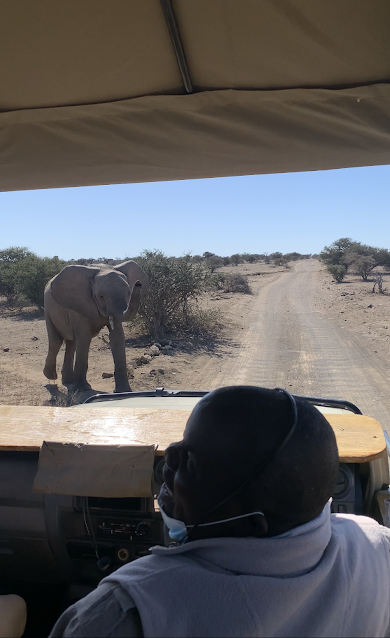 |
| Quick iPhone shot since I hadn't yet taken out my camera! You'd think I'd know by now... |
Once they passed, we saw a parked vehicle further down the road. We asked what they were looking at, and the two women told us they had spotted a leopardess with a three month old leopard cub. Unfortunately, the pair were concealed in the thickets so it wasn’t a photographic opportunity but still really special to see.
 |
| A photo for the memory! |
When we got to camp, we had a short camp orientation and room tour, dropped our stuff off in the rooms, and had a light lunch on the deck overlooking the waterhole before heading out on our afternoon game drive. Below are some scenes from around camp.
 |
| The entrance to camp. |
 |
| We had two bathrooms!! |
What is now Mashatu is also known as the Tuli Enclave. Over time, many different people occupied the region. The earliest evidence of the presence of man in Tuli can be seen in the numerous stone tool quarries. Many late stone age tools have been found scattered around the reserve where the San people practiced their hunter-gatherer lifestyle and nomadic pastoralism. The disappearance of these nomadic people coincides with the occupation of the region by the early Iron Age civilizations. Bantu speaking people who arrived from further north (also known as the Zhizo or Gokomere people) also occupied this area. This civilization saw their men sweating over small furnaces to fuse melted ores for weapons, tools, and ornaments. The Iron Age brought many changes to Tuli, including agriculture, domestication, and complex social structures. After these people came the Leopard's Kopje A or K2 people, and the Mapungubwe people later formed the Kingdom of Mapungubwe trading extensively with civilizations like East Africa, Arabia, and India. The first European explorers and missionaries arrived in the early 16th century, during which time the area was used for hunting, trading, and mission work among the tribes and people living there. At the end of the 19th century, Cecil John Rhodes came into the picture. He, along with a group of men known as the "Pioneer Column" were sent to annex Matabeleland and Mashonaland for the British Crown. He was ambitious and wanted to build a Cape to Cairo railway with the Tuli Block allocated to the British South African Company, but when that was determined to be a logistical nightmare, the Tuli Block was surveyed and divided into farms (which were then allocated to British owners in an effort to protect Botswana from the northward expansion of the Boers). The territorial aspirations led to various confrontations between the Boer and British forces in what is now known as the Northern Tuli Game Reserve.
Fast forward and Mashatu is now privately owned land in the conserved wilderness area known as the Northern Tuli Reserve. It's one of the largest privately owned game reserves in southern Africa and is a sanctuary to the largest herds of elephant on privately owned land on the continent. Even though it's privately owned, there are no fences so the free movement of wildlife between the three countries is not inhibited in the slightest. Mashatu means "Land of the Giants", taking its name from the locally sacrosanct Mashatu or Nyala berry tree and the giants that roam its terrain. Here you can find Africa's big seven land-based giants:
1. The largest herds of elephants on privately owned land. You can find them in herds between 10-50, or more.
2. Giraffes (the world's tallest mammal).
3. Elands (the world's largest antelope, and an excellent jumper).
4. Ostriches (the world's largest bird with a vicious kick).
5. Kori bustards (the world's heaviest flying bird). This bird is actually culturally significant here in Botswana and its said that only the chiefs may eat them. That said, they're a protected species due to illegal hunting.
6. Lions (Africa's second largest cat).
7. And finally, the iconic baobab tree. It's known to live for several thousand years and is leafless for up to 9 months of the year. Bushmen legend states that in the beginning, seeds and plants were distributed by the gods to the animals of the world to cultivate. The baobab was issued to the hyena, which was last in the queue, and he was so upset that he planted the tree upside down!
When you look at Mashatu's staff statistics, it's difficult to not be impressed by their immense experience when it comes to hospitality! Many of the Mashatu team members have spent a minimum of 12 months at Disney World in Orlando, Florida as part of an exchange program offered to citizens of Botswana. The average employment of guides is about 14 years, some as long as 36 years! And, during the 12-month Covid lockdown, Mashatu paid salaries to all staff, retaining all staff members in the company while the company was closed for commercial operations. All the above shows at camp. Having been to Mashatu, I can confidently say that it has become one of my all time favorite places in all of Africa.
But back to our time there... We spent our afternoon searching for cheetahs. It took quite some time, but we finally found six cheetahs (a mom with her nearly one year old cubs). The cheetahs were feasting on an impala kill, known as the McDonald’s of the bush because of the McDonald’s “m” logo shape on their rear. As the light started to get softer, their eyes became less squinty making for better photography.
On the morning of July 7th, we headed out in the early morning— our wake up call was at 5:30a.m. and we were in the car by 6a.m. We made our way up and down the steep riverbeds, holding on to the car's railing along with our cameras so we didn't go flying over the roof of the vehicle when we were almost completely vertical. For awhile, I tried to take videos of how steep of a descent and climb it is when you're continually going in and out of the riverbeds, but I needed one hand to hold on and one hand to hold my camera so I eventually gave up! Right when I started to think it was getting boring because we weren’t seeing anything in the riverbed, we came across a female leopard. She walked towards us, providing a fantastic first leopard viewing.
 |
| A wonderful sighting of a leopard in golden morning light. |
When we lost her, we drove to another leopard sighting— a male named Covid because he was born during the Covid lockdown in Botswana. Our guide and tracker (Aaron and Albert who we lovingly referred to as the "A team") informed us that he is the son of the female we saw in the morning.
 |
| I finally got the leopard photos I had always wanted! |
 |
| Taking a break to groom himself. |
Covid had an impala kill up in the tree and when he walked onto a rocky patch of land, we went back to the female. We spent the entire morning going back and forth between the two of them— not a bad start, considering my leopard curse!
 |
| Leopard pano. We left Covid here shortly after I took this. |
When we got back, it was time for brunch. In Africa, sometimes it’s more breakfast based but today it was more lunch based… veggie chow mein noodles for me! Following brunch, I had an hour long editing session with our photo guide where we worked on creative crops to diversify my image portfolio and make me consider new techniques.
In the afternoon, we went out for our first hide session. The photo hide is located roughly 30 minutes from camp and is situated in an underground bunker so you are eye level with the waterhole.
 |
| The entrance to the photo hide with the waterhole in the background. It looks small, but when you're inside, the waterhole looks large! |
You descend backwards down a steep metal staircase, attempting to lean forward as you go down so you don't hit your head on the metal door that closes, shutting you in, once everyone is situated inside. Once inside, there is a metal rack on the left where you lay out whatever camera gear you aren't using to ensure the floor remains clear of obstacles when you move around. To the right, there's a narrow, horizontal slit with a counter right in front of the opening.
 |
| Getting my cameras set up in the hide. |
There are cushioned stools with no backs, a mat on the wooden counter to provide traction, and bean bags on swivels lined up for cameras. Phone tripods are also provided which came in handy for all the timelapse videos I took! Unlike other areas in Africa, this hide has no glass so you can stick your cameras directly out of the narrow slit with no distortion or glare from a glass barrier.
 |
| Camera set up complete! |
For the first hour and a half, no animals came. We took our tea to go, so we munched on mango strips, banana chips, samosas, and little sandwiches while we whispered quietly to one another. Noise travels easily out here, and being as quiet as possible is a necessity to not only see animals but to ensure you don’t disturb them as well. Birds and smaller animals started showing up.
 |
| A tree squirrel comes to the photo hide for a drink. |
It’s the windy season in Mashatu now and at one point the photo hide manager said “turn your cameras around quick!” just as a massive dust cloud blew directly towards us. In a hide, it’s crucial to always leave your lens caps off because animals can approach from any direction and seeing as they don’t stay very long, it’s best not to fumble around with accessories. Most of the time, you don't even hear the animal approach... even the elephants!
 |
| Quick iPhone shot. |
Soon after, it was happy hour. An impala came to drink followed by a warthog, a herd of elephants, seven kudus, more impalas and lots of birds in between.
 |
| An impala makes its way towards the water. |
 |
| A warthog rolls around in the mud as a kudu approaches. |
While the elephants were incredible to see from eye level, and really “foot level” (we were looking directly at their feet!), the warthog turned out to be the highlight of our afternoon session. These comical creatures often run away from you, tails sticking straight up as they trot along. At the hide they approached us head on, something so rare that it’s probably the only time you’ll photograph them from the front.
 |
| Warthog headshot! |
This warthog in particular had the biggest personality, if animals can have personalities. It rolled around in the mud taking a mud bath as the kudus just stared at it as if thinking “what the heck are you doing?”. We were all cracking up and shortly afterwards, we ended a successful first hide session.
 |
| Mom and I in the hide while waiting for animals. |
After leaving the hide, we circled back to check on the two leopards from earlier that day. They were both still sleeping, but we found a lion. We didn’t have our tracker with us since we were only scheduled to go to the hide and our guide didn’t have a spotlight, so we used the car’s headlights to illuminate our subject. We followed the lion as it eagerly made its way towards the tree that the male leopard had stashed its impala kill in.
 |
| Circling the tree, this lion tried to steal a leopard's kill. |
After two attempts to climb the tree to scavenge the kill, it gave up and we followed it as it went to the water to drink. It was incredible to see this behavior. Earlier in the day we had decided we’d aim for an earlier dinner around 6:30p.m., but as we all know “TIA” (This Is Africa) and plans change. To quote our photo leader, "the best part about having a plan is breaking it". We had another beautiful dinner in the boma— mushroom soup, hake fillet with potatoes and grilled veggies, and sticky toffee pudding.
The morning of July 8th started in the best possible way: with a leopard. This leopard gave us a great opportunity to photograph a leopard yawning and when it laid down for a rest, we continued on to see lionesses with five cubs.
 |
| Leopard yawn! |
When we got there, the cubs were on a dead log but they quickly moved towards the riverbank before eventually heading into the thicket.
 |
| One of the cubs on a dead log. This was one of two photos I got of this because they jumped down so quickly! |
 |
| Lion cub in the thickets. |
By the time we were done with that sighting, it was near the usual time for our coffee break. Before that happened, we came across a leopardess hunting an impala. We watched her stalk in the riverbank, slouching with pronounced shoulder blades. At times, she was using our car as cover and slinked onto her belly to go under another safari car at the sighting.
 |
| While stalking, you can see just how pronounced the shoulder blades become. |
Keep in mind, leopards are nocturnal so any time you see behavior such as this it’s truly mind blowing. After watching her hunt, we stopped for our usual morning snack break: boiled eggs, rusks, and cookies. We had a game drive en route back to camp for brunch, but we didn’t see much. Brunch was served on the grassy area near the pool, a change from the patio we’ve been eating on. I had a yummy pizza with mushrooms, onions, and tomatoes. Following lunch, I had only an hour to shower and download images before a forty minute Lightroom session.
In the afternoon, the lodge set out tea for us on the patio overlooking the camp's waterhole. We had some elephant visitors, who we were watching as we ate little sandwiches and drank fresh squeezed lemonade.
 |
| Our afternoon tea spot at the lodge. |
When we went out on drive, it was a slow start to the afternoon. We photographed some impala under an impressive Mashatu tree (great chance for panos!), giraffe eating, an elephant splashing some mud in the riverbed, and backlit baboons.
 |
| The Mashatu trees are gorgeous, providing shade and food to the animals that come. |
 |
| Abstract shot of the elephant throwing water and mud. |
 |
| Backlit baboons. How cute is the little baby?! |
We found a sleeping lion in the thickets but he still wasn’t doing anything after sitting with him for some time, so we went back to the same male leopard (Covid) with his same impala kill.
 |
| One of my favorite leopard photos from the entire trip. |
 |
| Covid in the Shepherd's tree, for perspective. |
We used our vehicle’s spotlight to illuminate him until another car came. We asked them to use their spotlight because it was a better angle for photographs and they happily obliged.
 |
| Eating his impala kill. |
Myself and another guest briefly freaked out because we kept getting black stripes on our cameras. We’d see the leopard in the viewfinder while shooting but when we played the images back, a large portion of the photograph was missing. Of course, we thought our cameras were broken. Our photo guide checked all of our settings and after reassuring us that our settings were in fact correct, he was stumped. After mulling it over a bit, he figured out that since the last time he was in Mashatu, the rangers had gotten new LED spotlights that were making the cameras act up. At least it was the spotlight and not our cameras!! Since the photos weren’t coming out, we just sat and observed as the leopard dragged his kill to the highest point of the tree.
On July 9th, we had a morning photo hide session. Originally, we were supposed to have two morning hide sessions but the camp manager told us we could switch to an afternoon session if we wanted (we happily took him up on this because Mashatu’s resident photographer said we had a really good chance of seeing elephants in the afternoon). Today, we were with guests from another camp since we were still the only guests at Mashatu. The hide only holds eight people so with the five of us on the trip, there were only a few seats left. We sat together, getting arguably the best seats right in the middle of the hide. Again, it was fairly quiet in the beginning. We were hoping that the leopard or a lion would come to drink since we knew both had been in the area but no such luck. We saw lots of birds including green pigeons before “larger game” started coming.
 |
| A go-away-bird comes for a drink. |
 |
| An African green pigeon steps down for a drink. |
Again, we were visited by impala. We had a flock of guinea fowl approach us head on, and they were a mass of synchronized drinking until something sent them running.
 |
| Guineafowl line up to drink. |
We waited a few minutes and suddenly, there were elephants at the hide. It always amazes me how massive yet quiet elephants are. If you didn’t see them coming, you never would hear them.
 |
| An elephant and her baby drink together. |
 |
| When you have a long lens on and don't want to change it, you get creative with your angles! |
Earlier in the morning, we had all taken bets on when the elephants would come. Our photo guide and I both said 8:45a.m. and another guest said 8a.m.– she was spot on. When the elephants left, we had more warthogs come to visit. Then, another herd of elephants scared the warthogs away.
 |
| Elephants approach as a warthog family drinks. |
 |
| Warthogs kneel down for a drink. |
When that second herd of elephants left, the warthogs cautiously came back.
 |
| Mom in the hide, taken by our photo leader. |
 |
| Photographing elephants, taken by our photo leader. |
We also saw a heron which the photo hide manager had never seen at the waterhole before. When it left, the quelea flew in and out in their gorgeous murmurations— flutters of synchronized movement. I attempted to play with longer exposures and freezing movement, but they flew in from different directions and it was draining my batteries so quickly since I left the camera on so I stopped.
 |
| Quelea fluttering between the hide and some nearby trees. They'd settle on the branches, come for a drink, and then go back to the branches. They repeated this process several times. |
We had a third and final herd of elephants approach the hide. One of the calves was nursing from its mom right in front of us— an incredible encounter. Shortly after the elephants left, we did too. Before heading back to camp, our "A team" wanted to check on a leopard (the same female from when we arrived at the airstrip that we saw with the cub on the way to camp). Aaron and Albert told us that she was looking really hungry and was in need of a meal. She yawned several times, an indication that she would soon get up.
 |
| Another leopard yawn! |
She did... but not to hunt. She headed to the nearby Mashatu tree, which she proceeded to climb.
 |
| Starting to climb the Mashatu tree. |
We circled the tree, getting new angles as she walked up, down, and around the massive tree.
 |
| Sitting in the Mashatu tree overlooking a herd of impala. |
 |
| Starting to descend the Mashatu tree. |
Suddenly, she jumped down. She started stalking impala— our second hunting leopard of the trip! She inched closer and closer to a herd of impala in the nearby sage. The impala caught wind of her and started moving to the left, but one got spooked and ran to the right… right towards the leopard! One minute you could see the impala leaping through the sage and the next, you couldn’t. She had made a kill. We followed along as she dragged her prize through the sage and towards a thicket. Every now and then, she’d stop to catch her breath, heaving as she lugged its weight by its neck and dragging it between her legs.
 |
| Dragging her kill to the thickets. |
We sat with her as she positioned it deep into the thicket, increasing her chances that it would remain hidden while she fed and fetched her cub. After observing her, we went back to camp… nearly six and a half hours after we had left in the morning. What a way to start the day!
By the time we finished lunch, our first true “lunch” since we normally do a brunch, it was after 1p.m. and we headed back out at 3p.m. Almost immediately, we came across Covid (the male leopard that we’ve been photographing with his impala kill) fishing in a small pond in the riverbed. Yes, you did read that correctly. A leopard. Fishing. None of our guides had seen or heard of this behavior before. I joked that it was because he was born during Covid and that he didn’t have his proper “how to be a leopard” lessons. He moved with intent— using his massive paws to turn over rocks and dig under the mud.
 |
| Pawing at the water to turn up fish. |
He’d chase what we thought was tilapia unsuccessfully and then return to the same rock to paw at it. He ran towards us and pounced—he emerged from the water with a catfish in his jaws.
 |
| Success! |
He thought he killed it and dragged it to the top of the riverbank while he fished for another one. We looked up and saw the catfish flopping sideways back towards the water… it wasn’t yet dead after all. Comically, it fell onto the leopard’s head and into the small pond he was fishing from. He looked confused for a moment, caught that fish again, and dragged it back up the bank. Then, he resumed and ended up catching catfish number two.
 |
| Leaping to catch another fish. |
.jpg) |
| Chasing a fish in the small pond. |
He put that one on a rock while he dragged the first kill up towards a thicket. We left him to enjoy his snack. From there, we drove about forty-five minutes to see the three lionesses with the five cubs— the ones we had seen before. Right before we got there, they had apparently chased a leopard up a tree. We watched the little ones play and eagerly follow the lionesses, squealing for milk. They went down the steep riverbank and into the riverbed.
 |
| Sibling tackle! |
 |
| Mom and cubs run down a hill into the riverbed. |
 |
| Playtime is over... these cubs wanted to nurse! |
We followed them as they settled in the road, during which time someone dropped their lens hood onto the ground. Before we had a chance to grab it, the lion cubs came running towards us, closer and closer to the lens hood. One looked like it might pick it up to play with it, but thankfully all five of them walked past it. Now the question of how to get it remained. Here we were, with lions all around us, with a lens hood on the ground and no indication that the lions were going to move anytime soon. So what do we do? Our ranger backed up, blocking the lions’ view of the lens hood so they could quickly jump out of the vehicle and retrieve it. As the light faded, we decided to call it a night. On the way back to camp we saw leopard number six: a skittish male. After dinner, it was time for bed to prepare for the long travel day ahead.
If you'd like to be notified of new blog posts via email, go to my blog's homepage (globetrotting-elissa.blogspot.com), enter your email address, and click the submit button on the right side of the email box. A pop up should come up asking you to verify the Captcha. Checkmark that box, and hit "complete subscription request". As always, follow my Instagram @elissatitle for photos, and stay tuned for more!








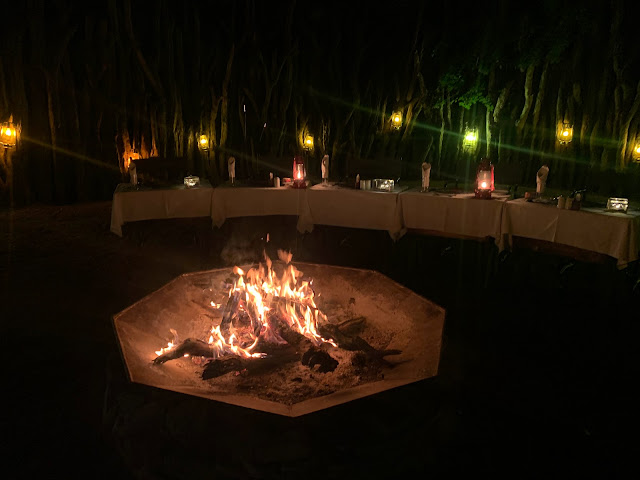
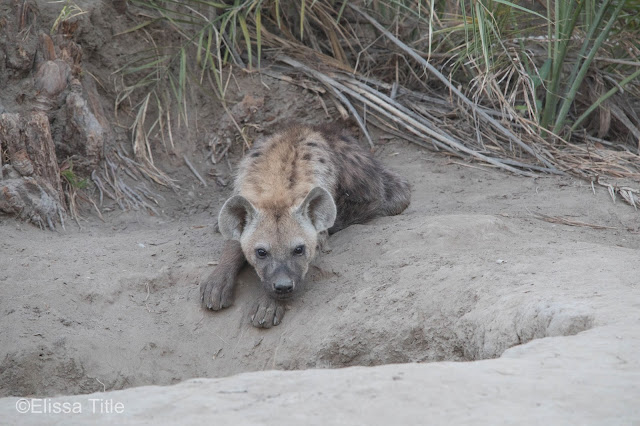




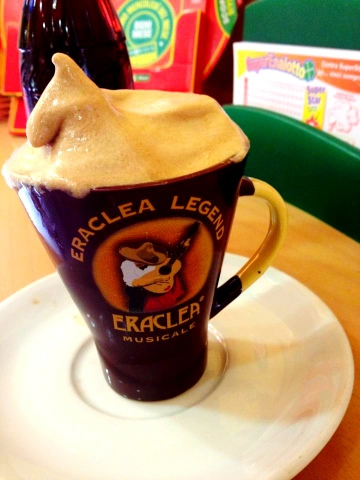


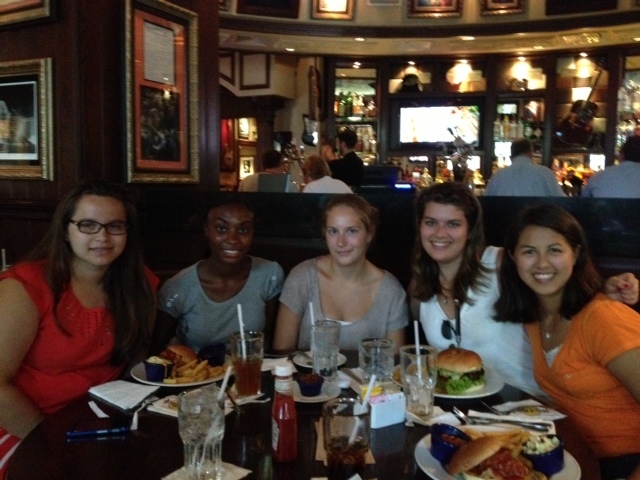
Comments
Post a Comment